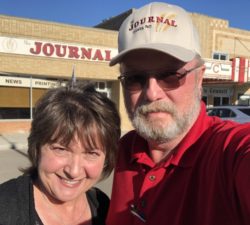Take Crosby, North Dakota, population 1,300, for instance. It’s located in the upper northwest corner of the state, approximately 35 miles east of Montana and six miles south of the Canadian border. Many folks there have an extraordinary interest in the public notices published in the local paper, the Journal.
“Sometimes we get calls from people aware of something happening in town and wondering why a notice about it wasn’t published in the paper,” says Cecile Wehrman (pictured on left in photo above), the Journal’s editor and publisher.
With a readership so attuned to official notice, perhaps it’s fitting the Journal won this year’s PNRC Public Notice Journalism Contest. Honorary public-notice reporting Hall-of-Famer Jim Lockwood, of the Times-Tribune in Scranton, Pa., and the Grand Forks (N.D.) Herald, were awarded second- and third-place, respectively. The winners were announced last month by the National Newspaper Association, which administered this year’s competition.
The Journal won the award for a story by veteran reporter Brad Nygaard (on the right in the photo) — Wehrman’s husband — based on what was ostensibly a run-of-the-mill notice about a Nov. 21, 2019, meeting of the Divide County Commission. Crosby is the county seat.
The notice informed citizens that the purpose of the meeting was to seek public input to determine if the county should abolish electoral districts, which might change who is eligible to run for a seat on the commission. Nygaard’s front-page story questioned whether the county had the authority to change its election procedures by resolution, the mechanism recommended by County Attorney Seymour Jordan. “My suggestion is to have a public meeting and see what happens,” said Jordan, shrugging off concerns about his legal analysis. “You can always put it to a vote if people don’t like the resolution.”
Following the Journal’s front-page alert, about 20 people attended the meeting — a huge turnout for this county of 2,300 people, according to Nygaard and Wehrman. “Folks drove in from all over the county,” Nygaard says.
Turns out the residents of Divide County aren’t as relaxed as their county attorney about changing election procedures. “We heard a lot of, ‘If it ain’t broke, don’t fix it,’ at the meeting,” says Nygaard. When the commission chairman asked, “How many here are in favor of not having districts?”, not one of the attendees said a word. And that was the end of Divide County’s casual flirtation with new election procedures.
The Journal’s award-winning story about the meeting notice wasn’t an outlier. The paper writes frequently about information contained in the notices within its pages. An article by Nygaard published earlier this summer is one of the most unusual public-notice stories we’ve ever read. It focused squarely on the deficiency of a notice for a public hearing on zoning changes relating to the potential construction of a Dollar General store in Crosby.
“The notice does not inform the public the hearing relates to a proposed change from agricultural to commercial zoning, or that it will involve approval of a plat, or subdivision, of the property,” wrote Nygaard. The notice also failed to “indicate the scope or size of the project” or “advise citizens they have the right to view the application or request copies of it,” he reported. And it mistakenly listed Dollar General as the applicant, instead of the company that planned to develop the property and lease it to the retailer.
The story also noted the property at issue had been annexed by the city last year during a previous council meeting, but the annexation had not yet been recorded.
“The Journal contacted city attorney Seymour Jordan by email last week making him aware of the apparent deficiencies in the hearing notice, but no further corrections or additions had been received as of press time,” wrote Nygaard. (Jordan is the attorney for both the city and county.)
You may not be surprised to learn that local government officials are not always happy with Nygaard and Wehrman despite their helpful advice.
“This isn’t our first rodeo,” notes Wehrman, who has been at the Journal for 20 years and also owns the Tioga Tribune, published about 50 miles southeast of Crosby. “When we see a notice, we may already have prior experience with it,” she says. “I was here when they did it before.”
And when they see something wrong with a notice they let their clients know. But public officials often ignore their concerns. “This type of disregard is becoming more apparent in recent months,” says Wehrman. “In my mind, it ties back to the lack of accountability on the federal level. We’ve always had a somewhat adversarial relationship with some public officials, but these days it seems the national attacks on the press have come home to roost in a local attitude among elected officials that they don’t have to answer to the press. They forget that’s the same as saying what the public thinks doesn’t matter.”
Our second-place winner, Jim Lockwood, won the award in 2015 and has come in second place in every PNRC contest since then. He has also won the public notice category in the Pennsylvania NewsMedia Association’s annual journalism contest every year since it was first included in the competition in 2014. This year’s package of articles included in Lockwood’s entry was even larger than usual, with 26 separate stories covering topics ranging from the disposal of landfill “garbage juice” to city employee gas-card usage and the potential building of a homeless shelter.
Third place went to the Grand Forks Herald for its coverage of a reporter from a different paper who faced threats and abuse from city officials after questioning whether the Roosevelt (Minn.) City Council had properly noticed a special meeting. The incident itself and the Herald’s ensuing coverage led to the resignations of the city administrator and a councilman. And all but one of the remaining council members were defeated in the following election by candidates who stressed the issue of transparency.

